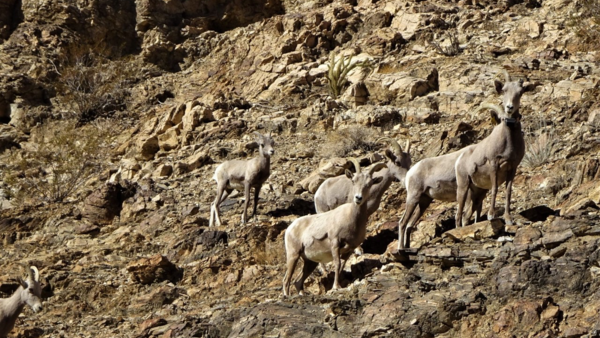Biodiversity writ large
"It is that range of biodiversity that we must care for — the whole thing — rather than just one or two stars.” — Sir David Attenborough
That range of biodiversity includes the panoply of life occupying a region. Everything from charismatic species (those one or two stars), bighorn sheep, collared lizards, wolves, and mountain lions, to microscopic soil organisms. Everything from diaphanous-winged butterflies and damselflies to the parasitic wasps that keep insect populations from becoming so numerous that they would otherwise consume all plant life on earth. Everything from towering sequoias to pond scum. Those microscopic soil organisms are essential for helping plants convert inorganic minerals to the building blocks of life and for capture moisture in an ever more arid desert. That pond scum is an organic factory converting sunlight and carbon dioxide to oxygen.
In 1798, Thomas Malthus, an English economist, published an essay on the principle of population growth. Malthus’ math was elegant, and its conclusion undeniable. In the absence of factors that limit population growth, populations will grow geometrically until some critical food resource was exhausted and then the population would crash into oblivion. Malthus was thinking humans, but his conclusions are applicable to all species.
Arguably no other document was as inspirational to both Charles Darwin and Alfred Russel Wallace for their independent development of the Theory of Natural Selection. Malthus’ math was clear; based on any species’ reproductive capacity, we should be neck-deep in lizards, spiders, voles, wrens, bighorn sheep and coyotes. Obviously, that is not the case, but from those two conclusions, what the math predicted and what we can see with our own eyes, Darwin and Wallace deduced that species underwent a struggle for existence. That struggle included within and between species competition, avoiding predation, parasitism, disease, and natural disasters. That struggle was real and intense enough that only those individuals that could survive those challenges would ultimately survive and pass their genes on to the next generation. So, species are being subjected to an on-going gauntlet of threats, as are the parasites and viruses and predators, ensuring that species do not reach such numbers that their populations would then crash into oblivion.
Aldo Leopold, in his essay “Thinking like a Mountain," acknowledged that early on he too fell into the trap of valuing species as “good” or “bad." “Good” species were those charismatic vegetarians like deer and sheep and squirrels. “Bad” species were non-human carnivores, wolves and coyotes and mountain lions. Leopold, in his early years, sought to rid the rangelands of predators to ensure that deer and other “good” species could proliferate. Proliferate they did, so much so that they ate all the available palatable plants, the forests and rangelands were degraded, and the deer began to die of starvation. It was a mistake people have repeated and continue to repeat to this day. Mountain lions and wolves are now gone from eastern North America, and the deer populations have exploded causing widespread starvation and disease. Not long ago I heard a local bighorn sheep biologist celebrate the death of a mountain lion because it meant more sheep would survive, but he did not include the reality that “his” sheep now face hillsides incrementally devoid of palatable food and flowing springs because of climate change.
A few years back I attended a lecture by a young biologist telling of his efforts to explain to cattle ranchers why their animals were faced with food shortages. The ranchers were convinced that the bison, who shared the grasslands with their cattle, had become too abundant and needed to be “culled." The biologist patiently explained that, based on his analyses, that the bison and cattle were selecting different plants to eat. The ranchers argued back that the bison must be to blame. The biologist again patiently explained that it was not the bison, it was jackrabbits that were competing with their cattle for food. The ranchers stared is silence, trying to identify where the biologist’s analysis and logic had been in error. One of the ranchers finally spoke, not to the biologist but to the other ranchers, and said that perhaps they (the ranchers) had been overzealous in killing coyotes. A healthy coyote population would have kept the jackrabbit population from a Malthusian population trajectory, and so would have left sufficient forage for bison, jackrabbits, and the ranchers’ cattle. Attenborough’s call for to care for and protect biodiversity, all species (including humans), is the only sane path forward.
